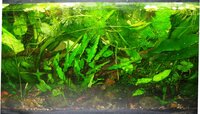Ravenswing
Member
Hi again!
This has been discussed every now and then and -where, according to some discussions or conclusions it is harmfull to have N2 gas in aquarium but on the second place its just good for plants and just one nice and easy way to get rid of N (NO3). I guess this varies and maybe depends more or less on circumstances (planted/non-planted etc ) or...not? Some say it is actually good to have a lot of anaerobic reactions in a tank to get rid of NO3 and that much oxygen is not even needed. Then why it is usually recommended to have as much oxygen into biological filters as ever possible and avoid filter clogging? How about BOD? Would someone like to clarify this a bit, please, since I dont`understand the whole puzzle yet and all that information seems to be a bit conflicting? BTW, Iv never owned a canister filter so no idea how they work ideally and at optimum level....
Cheers, Maria
This has been discussed every now and then and -where, according to some discussions or conclusions it is harmfull to have N2 gas in aquarium but on the second place its just good for plants and just one nice and easy way to get rid of N (NO3). I guess this varies and maybe depends more or less on circumstances (planted/non-planted etc ) or...not? Some say it is actually good to have a lot of anaerobic reactions in a tank to get rid of NO3 and that much oxygen is not even needed. Then why it is usually recommended to have as much oxygen into biological filters as ever possible and avoid filter clogging? How about BOD? Would someone like to clarify this a bit, please, since I dont`understand the whole puzzle yet and all that information seems to be a bit conflicting? BTW, Iv never owned a canister filter so no idea how they work ideally and at optimum level....
Cheers, Maria



